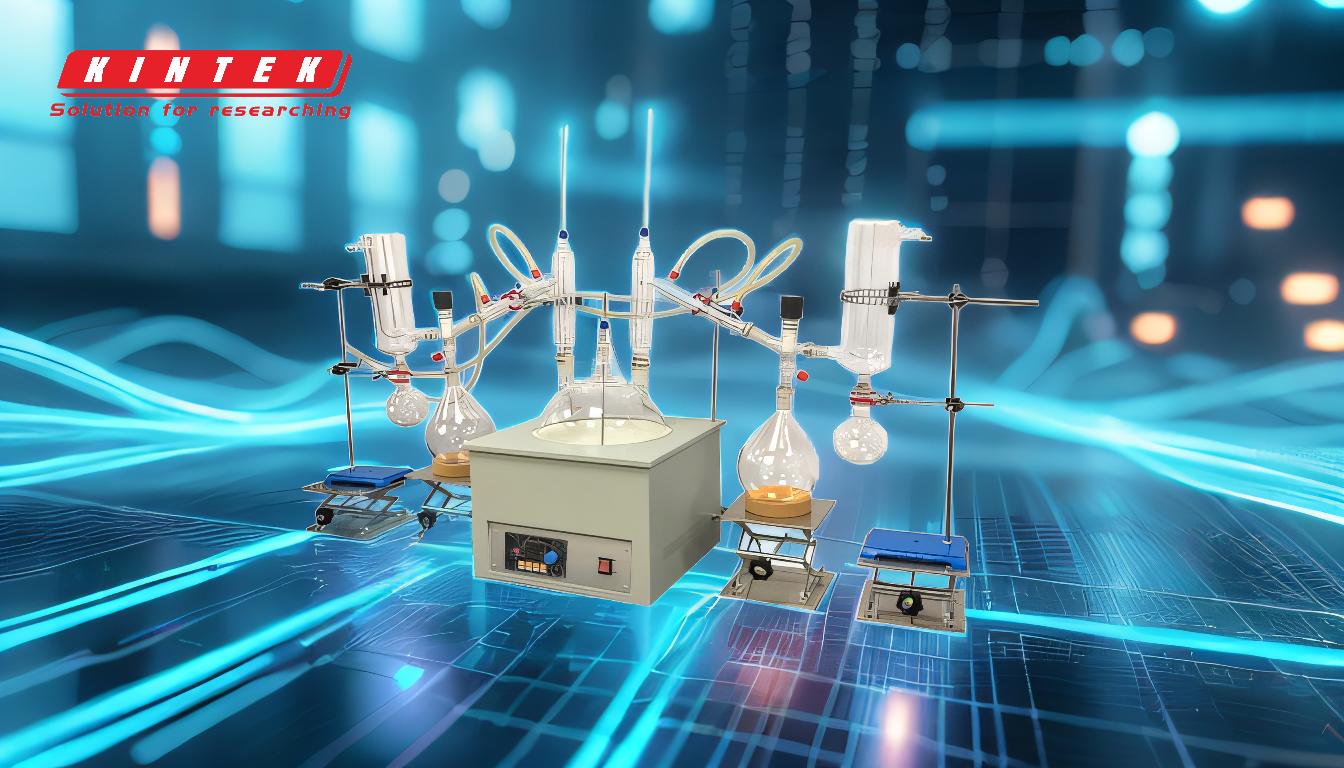Vacuum distillation is a specialized technique used to separate or purify liquids with high boiling points or those that are thermally sensitive. By reducing the surrounding pressure, the boiling points of these liquids are lowered, enabling distillation at temperatures that prevent decomposition or degradation. This method is particularly useful for obtaining high-purity compounds, isolating thermally labile substances, and separating complex mixtures that would otherwise require impractical or damaging high temperatures. It is widely applied in industries such as petrochemicals, pharmaceuticals, and fine chemicals, where precision and preservation of compound integrity are critical.
Key Points Explained:

-
Handling High Boiling Point Liquids:
- Why it matters: Many liquids have boiling points so high that heating them to these temperatures is impractical or impossible without causing decomposition.
- How vacuum distillation helps: By lowering the pressure, the boiling point of the liquid is reduced. For example, a compound that normally boils at 500°C might boil at 200°C under reduced pressure, making distillation feasible without thermal damage.
- Example: In the petrochemical industry, vacuum distillation is used to separate heavy crude oil fractions that would otherwise decompose at their atmospheric boiling points.
-
Preventing Thermal Decomposition:
- Why it matters: Some compounds are thermally unstable and degrade or decompose when exposed to high temperatures.
- How vacuum distillation helps: By distilling at lower temperatures, the risk of decomposition is minimized, preserving the integrity of the compound.
- Example: Pharmaceutical compounds, such as certain antibiotics or vitamins, often require vacuum distillation to isolate them without breaking down their molecular structure.
-
Obtaining High-Purity Samples:
- Why it matters: High-purity compounds are essential for research, manufacturing, and quality control in industries like pharmaceuticals and electronics.
- How vacuum distillation helps: The process allows for precise separation of components, reducing contamination and yielding a purer distillate.
- Example: In the production of essential oils, vacuum distillation ensures that the final product is free from contaminants and retains its aromatic properties.
-
Energy Efficiency:
- Why it matters: Heating liquids to extremely high temperatures requires significant energy, which can be costly and environmentally taxing.
- How vacuum distillation helps: By lowering the boiling point, less energy is needed to achieve distillation, making the process more efficient and cost-effective.
- Example: In large-scale chemical manufacturing, vacuum distillation reduces energy consumption compared to traditional distillation methods.
-
Separation of Complex Mixtures:
- Why it matters: Some mixtures contain components with similar boiling points, making separation difficult under standard conditions.
- How vacuum distillation helps: The reduced pressure can enhance the separation of closely boiling components, especially when combined with techniques like fractional or steam distillation.
- Example: Aromatic compounds in the fragrance industry are often separated using vacuum distillation to achieve precise and consistent results.
-
Versatility in Applications:
- Why it matters: Different industries have unique requirements for distillation processes.
- How vacuum distillation helps: Its adaptability allows it to be used in various applications, from refining petroleum to purifying sensitive biochemicals.
- Example: In the food industry, vacuum distillation is used to concentrate flavors and fragrances without damaging heat-sensitive compounds.
-
Combination with Other Techniques:
- Why it matters: Some separations require multiple methods to achieve the desired purity or efficiency.
- How vacuum distillation helps: It can be combined with fractional or steam distillation to enhance separation efficiency, particularly for complex mixtures.
- Example: In the production of essential oils, vacuum distillation is often paired with steam distillation to extract and purify volatile compounds effectively.
-
Environmental and Safety Benefits:
- Why it matters: High-temperature processes can pose safety risks and environmental concerns due to energy consumption and emissions.
- How vacuum distillation helps: By operating at lower temperatures, vacuum distillation reduces the risk of fire, explosion, and harmful emissions, making it a safer and more sustainable option.
- Example: In the chemical industry, vacuum distillation is preferred for handling hazardous or volatile substances to minimize risks to workers and the environment.
By addressing these key points, vacuum distillation emerges as a critical technique for industries and applications where precise separation, thermal sensitivity, and energy efficiency are paramount. Its ability to operate under reduced pressure makes it a versatile and indispensable tool for modern chemical and industrial processes.
Summary Table:
| Key Benefit | Explanation | Example |
|---|---|---|
| Handling High Boiling Points | Reduces boiling points, enabling distillation without thermal damage. | Separating heavy crude oil fractions in petrochemicals. |
| Preventing Thermal Decomposition | Distills at lower temperatures to preserve compound integrity. | Isolating antibiotics or vitamins in pharmaceuticals. |
| Obtaining High-Purity Samples | Precise separation reduces contamination, yielding purer distillates. | Producing contaminant-free essential oils. |
| Energy Efficiency | Lower boiling points reduce energy consumption. | Large-scale chemical manufacturing processes. |
| Separation of Complex Mixtures | Enhances separation of closely boiling components. | Aromatic compound separation in the fragrance industry. |
| Versatility in Applications | Adaptable for refining petroleum, purifying biochemicals, and more. | Concentrating flavors and fragrances in the food industry. |
| Combination with Other Techniques | Works with fractional or steam distillation for better efficiency. | Essential oil production with combined distillation methods. |
| Environmental and Safety Benefits | Safer and more sustainable due to lower temperatures. | Handling hazardous substances in the chemical industry. |
Learn how vacuum distillation can optimize your processes—contact our experts today!













